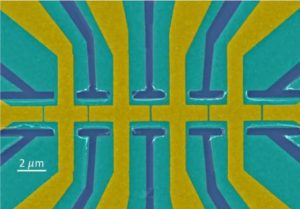The Ando group has developed a new methodology to realize proximity-induced superconductivity in a topological-insulator nanowire. The work was conducted in cooperation with the Ernst Ruska-Centre for Microscopy and Spectroscopy with Electrons at Forschungszentrum Jülich.
Publication: Bai, M., Wei, XK., Feng, J. et al. Proximity-induced superconductivity in (Bi1−xSbx)2Te3 topological-insulator nanowires. Commun Mater 3, 20 (2022). https://doi.org/10.1038/s43246-022-00242-6

False-color SEM image of the wafer including device 1 (2nd left junction); Pd electrodes (dark-yellow), BST film (turquoise), and sapphire substrate (dark-blue) are visible. The five junctions pictured here were fabricated with the Pd gap ranging from 100 to 150 nm (from left to right).
Absract: When a topological insulator is made into a nanowire, the interplay between topology and size quantization gives rise to peculiar one-dimensional states whose energy dispersion can be manipulated by external fields. In the presence of proximity-induced superconductivity, these 1D states offer a tunable platform for Majorana zero modes. While the existence of such peculiar 1D states has been experimentally confirmed, the realization of robust proximity-induced superconductivity in topological-insulator nanowires remains a challenge. Here, we report the realization of superconducting topological-insulator nanowires based on (Bi1−xSbx)2Te3 (BST) thin films. When two rectangular pads of palladium are deposited on a BST thin film with a separation of 100–200 nm, the BST beneath the pads is converted into a superconductor, leaving a nanowire of BST in-between. We found that the interface is epitaxial and has a high electronic transparency, leading to a robust superconductivity induced in the BST nanowire. Due to its suitable geometry for gate-tuning, this platform is promising for future studies of Majorana zero modes.